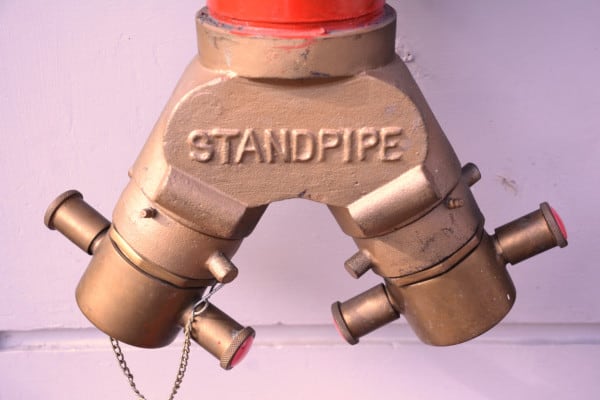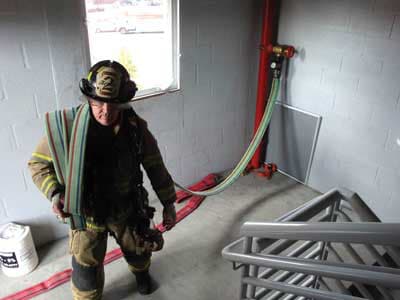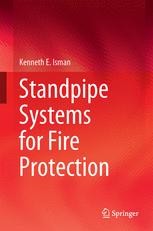Best Describes Standpipe and Hose Systems
These are typically found in cabinets with 100 of hose. Standpipe systems are installed in buildings to help firefighting personnel deploy attack hoselines quickly and with adequate water pressure and volume to suppress a fire.

Fire Protection Standpipe System Overview And Introduction To Nfpa 14
Standpipe systems normally discharge water outside of the protected building.

. The requirements for completing a hydraulic calculation for a standpipe system are contained in Section 71012 of NFPA 14. Section 33203 of the 2019 edition of NFPA 14. If so your annual education program as you described does meet the intent of 1910157g1 through g4 for those employees who have not been designated members of the fire brigade.
You put water in one end and hope that. List and describe the different types of standpipe systems. A more than 3 storeys in building height b more than 14 m high measured between grade and the ceiling of the top storey or.
They are most common in large floor area buildings. Contains pressurized air in the pipe. The fire sprinkler system and standpipe system share a common riser.
Class III standpipe systems. Which class of standpipe system is equipped with a 1 12 inch hose and lightweight twist-type shutoff nozzle stored on a hose rack system. STANDPIPE AND HOSE SYSTEMS.
Which of the following statements BEST describes standpipe and hose systems. Preferred type of system - automatic dry. Class III A Class III standpipe system shall provide 1 12 inch hose stations to supply water for use by trained personnel and.
542 Class II and Class III Standpipe SystemsClass II and Class III standpipe systems with 1 ½ in hose stations shall be automatic wet systems unless located in a facility where piping is. Contains water in the pipes at all times and is required to supply sufficient quantities of water to support manual firefighting operations. However after the effective date of this standard unlined hose which becomes unserviceable shall be replaced with lined hose.
We believe that you intended to refer to 1910157g1 through g4 rather than 1910158 1910158 covers standpipe and hose systems. Class II A Class II standpipe system shall provide 1 12 inch hose stations to supply water for use primarily by trained personnel or by the fire department during initial response. The system delivers water to hose connections throughout the.
Standpipe systems are designed to pro-vide fire protection water for hose lines in strategically placed locations inside a building or structure. Standpipe and Hose systems. It is filled with air under pressure.
It uses a valve similar to a dry pipe sprinkler valve that releases water into the standpipe system when a hose station outlet is opened. Standpipe systems consist of a fixed piping system and hose valve connections to preclude the need for long hose lays within tall or large buildings. C not more than 14 m high measured between grade and the ceiling of the top storey.
Unlined hose may remain in use on existing systems. A combined system of hoses used by in-house personnel trained in hose operations. Water does not enter the piping until a hose.
It requires activation of a control device to provide water at hose connections. Fixed-temperature heat detectors are activated by expansion of heated material changes in resistance of heated material and. Standpipe systems are described by classes to indicate their fire protection performance.
The following list highlights minimum requirements for the essential care of standpipe and hose systems. This list however is not meant to replace manufacturers. A 2-12 inch hose connection for use by fire departments and those trained in handling heavy fire streams.
For standpipe systems based on the hose connection provided as follows. Design and installation of standpipe systems and hose stations are described in NFPA 13 and NFPA. NFPA defines a standpipe as an arrangement of piping valves hose connections and associated equipment installed in a building or structure with the hose connections located in such a manner that water can be discharged in streams or spray patterns through attached hose and nozzles for the purpose of extinguishing a fire thereby protecting a building or.
A 1-12 inch hose system that provides a means for the control or extinguishment of incipient stage fires. Standpipe systems may not be effective on small fires in their early stages. Wet or dry system of pipes in a large single-story or multistory building with fire hose outlets installed in different areas or on different levels of a building to be used by firefighters andor building occupants.
Inspection testing and maintenance of standpipe and hose systems shall be performed in accordance with the manufacturers instructions and NFPA 25 latest edition. Standard for the Installation of Standpipes and Hose Systems defines a combined system as. Standpipe systems are like a big black hole.
Class II standpipe systems. Design and installation of standpipe systems and hose stations are described in NFPA 13 and NFPA 14. Types of standpipe systems.
Which of the following statements BEST describes standpipe and hose systems. Class I standpipe systems. This standpipe type is connected to a permanent water supply capable of meeting flow and pressure requirements.
A standpipe system that supplies both hose connections and automatic sprinklers. Which of the following statements BEST describes standpipe and hose systems. To perform the system hydraulic calculation the required flow and pressure at the most hydraulically remote hose outlet is determined and the.
Standpipe systems installed after January 1 1981 for use by employees shall be equipped with lined hose. The late Andy Fredericks once said. Class I standpipes are designed for use with 2½-in 65-mm hoses and are intended for heavy fire streams ie 250 gpm 946 lpm operated by the fire department.
_____ _____ - This is a standpipe system that is attached to a water supply that is capable of supplying the system demands at all times. Water is fed into these systems either through an automatic water supply or manually through a fire department connection. They may be designed for heavy stream applications as first aid fire appliances or have the features of both.
Design and installation of standpipe systems and hose stations are described in NFPA 13 and NFPA 14. The procedure is similar to the calculation method for a sprinkler system. Standpipe systems while many newer buildings will have a combination sys-tem which supplies the fire sprinkler system and the standpipe system.
1 a standpipe system shall be installed in a building that is.

Fire Protection Standpipe System Overview And Introduction To Nfpa 14

Chapter 07 Standpipe And Hose Systems Ppt Fire Detection And Suppression Systems Chapter 7 Standpipe And Hose Systems Learning Objective 1 List Course Hero

Standpipe Systems For Fire Protection Springerprofessional De
No comments for "Best Describes Standpipe and Hose Systems"
Post a Comment